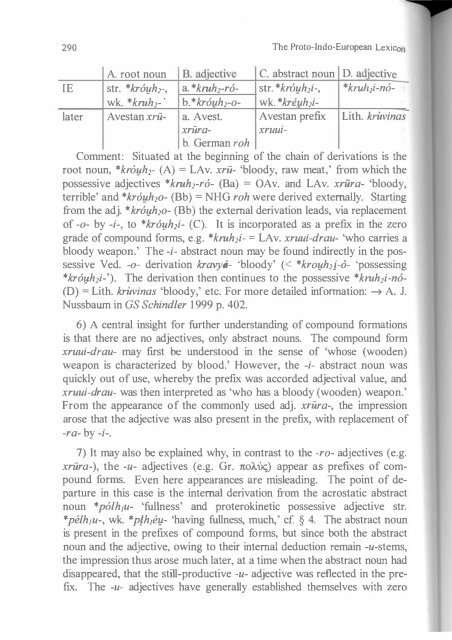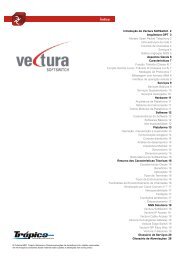You also want an ePaper? Increase the reach of your titles
YUMPU automatically turns print PDFs into web optimized ePapers that Google loves.
290 The Proto-Indo-European LexiconA. root noun B. adiective C. abstract noun O. adiectivelE str. *kroljh,-, a. *krnh,-ro- str. *krOljh,i-, *krulzzi-no- -wk. *krnh,- ' b*krouh,-o- wk. *krliuh,ilaterA vestan xru- a. Avest. A vestan prefix Lith. kruvinasxriira- xruuib.German rohComment:Situated at the beginning <strong>of</strong> the chain <strong>of</strong> derivations is theroot noun, *krOyh,- (A) = LAv. xrn- 'bloody, raw meat,' from which thepossessive adjectives *krnh,-ro- (Ba) = OAv. and LAv. xrnra- 'bloody,terrible' and *kroyh,o- (Bb) = NHG roh were derived externally. Startingfrom the adj. * kroljh,o- (Bb) the external derivation leads, via replacement<strong>of</strong> -0- by -i-, to *kroyh,i- (C).It is incorporated as a prefix in the zerograde <strong>of</strong> compound forms, e.g. *krnh,i- = LAv. xruui-drau- 'who carries abloody weapon.' The -i- abstract noun may be fo und indirectly in the possessiveVed. -0- derivation kravya- 'bloody' « *kroyh,j-o- 'possessing*kroljh,i-'). The derivation then continues to the possessive *krnh,i-no(0) = Lith. kruvinas 'bloody,' etc. For more detailed infonnation: -7 A. 1.Nussbaurn in GS Schindler 1999 p. 402.6) A central insight for further understanding <strong>of</strong> compound fo rmationsis that there are no adjectives, only abstract nouns. The compound fo rmxruui-drau- may first be understood in the sense <strong>of</strong> 'whose (wooden)weapon is characterized by blood.' However, the -i- abstract noun wasquickly out <strong>of</strong> use, whereby the prefix was accorded adjectival value, andxruui-drau- was then interpreted as 'who has a bloody (wooden) weapon.'From the appearance <strong>of</strong> the commonly used adj. xrnra-, the impressionarose that the adjective was also present in the prefix, with replacement <strong>of</strong>-ra- by -i-.7) It may also be explained why, in contrast to the -ro- adjectives (e.g.xriira-), the -u- adjectives (e.g. Gr. 1tOI..) appear as prefixes <strong>of</strong> compoundfo rms. Even here appearances are misleading. The point <strong>of</strong> departurein this case is the internal derivation from the aerostatic abstractnoun *p6lh/u- 'fullness' and proterokinetic possessive adjective str."pelh/u-, wk. "p!h/elj- 'having fullness, much,' cf § 4. The abstract nounis present in the prefixes <strong>of</strong> compound fo rms, but since both the abstractnoun and the adjective, owing to their internal deduction remain -u-stems,the impression thus arose much later, at a time when the abstract noun haddisappeared, that the still-productive -u- adjective was reflected in the prefix.The -u- adjectives have generally established themselves with zeroword Formation 291stem roots, cf. here Ved. puru-. The -0- <strong>of</strong> Gr. 1tOI.. was long misunderstood,but is now recognized as coming from an abstract noun.3. Word Formation by CompositionW 207. The possibility <strong>of</strong> fo rming compound words dates from ProtoIndo-European and consists <strong>of</strong> the joining <strong>of</strong> two nominal stems, a firstelement, and a second element. -The first element is norrnally composed<strong>of</strong> a simple stem while the second element may be inflected: The stem ISeither used directly, or in combination with a suffix such as " -0-, *-i-,*-ijo-, etc. The new noun receives its own accent aod a new meaning. Two types <strong>of</strong> PIE models are the possessive compounds (called bahuvnhlin Old Indian terminology, meaning 'having much rice') and the verbalgovernment compounds. Proto-Indo-European itself features several establishedtypes <strong>of</strong> both models.1) In the case <strong>of</strong> the possessive compound, nominal phrases such as Gr.t = !!EA.a 'the horse [is] black' becomes the noun I..OV-t1t1tO-. Intltis case, the compound fo rm serves to characterize a person, namely one,'who owns a black horse/rides on a black horse.' As a rule, prefixes findtheir origin in abstract nouns, cf. W 206 § 6. See further W 208 below.2) In the case <strong>of</strong> the verbal government compound, a verbal sentence <strong>of</strong>the type Gr. ICOUpOV PEq,et '(the wet nurse) feeds a male child' is nominalizedto fo rm ICoupo-p6$O-. In order to make the compound form possiblethe finite verb is transformed into an abstract noun, here in the fo rm<strong>of</strong> .;p6$O"The newly formed word indicates a person 'who goes aboutthe feeding <strong>of</strong> children.' See further W 209 below.3) The genesis <strong>of</strong> compound forms that is described here, with the example<strong>of</strong> Greek, most likely took place in the pre-Proto-Indo-Europeanperiod: -7 J. Wackernagel in Wackernagel / Oebrunner Ai. Gramm. II / 11957 (first edition, 1905) p. 289 (dealing with possessive compoundfo rms) and p. 186 (on verbal government compounds); Risch KleineSchriften 1981 (in a contribution from 1945) p. 124, note 21.4) Terminology concerning compound fo rms is not completely uniform.On the one hand, there is a relatively comprehensive Old Indian terminologywhich is fully adapted to the classical circumstances peculiar to OldIndian and built up purely in terms <strong>of</strong> content: -7 J. Wackernagel in Wackernagel/ Oebrunner Ai. Gramm. II / 1 1957 p. 140-142. On the other





